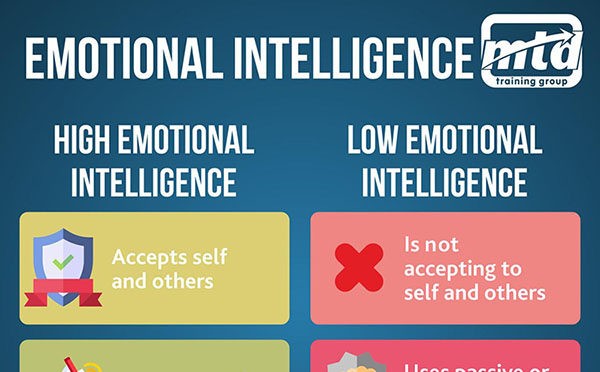🏢 9,000+ Organisations
🏆 6 x L&D/HR Awards
⭐ 4.8/5 Highly Rated
🧠 24 Years' Experience

There’s little doubt that emotional intelligence is one of the areas businesspeople have heard of and know maybe a little about. But what is it about this strange component of human interaction that has such an impact on us personally as well as inter-personally?
One definition of emotional intelligence or (EQ) is ‘the interaction between a person themselves and others at the deep emotional level’. As emotions play such a key part in our lives, how can we notice if our EQ is at a high, medium or low level.
Here are just three areas of the skill that we’ve highlighted and compared what we see when we experience high versus low levels of EQ.
High: Accepting self and others
Low: Not accepting of self and others
By acceptance, I’m referring to the ability of an individual to validate themselves or others, and a person’s consent to the reality of a situation, without trying to change or manipulate it or the person.
High EQ means the person can see the good and bad in themselves and allow those two imposters to be worked on, encouraging an openness of the meaning behind what is being manifested. We stop resisting and accept that which we can’t change.
Low EQ means the person is always critical, judging themselves and others sometimes against standards that are unreachable or unattainable.
The ability to see what can and can’t be changed and accepting others for themselves without pre- or post-judgement helps us as individuals to develop the qualities of patience, resilience, perseverance and overall acceptance.
High: Can communicate assertively
Low: Uses passive or aggressive communication
Often, assertive behaviour is confused with aggressive, and so people feel they have to be ‘nice’ to others and this doesn’t not involve being assertive.
To be honest, there is a big difference between assertiveness and aggression. Aggression is where we trample over the rights of others in favour of our own, whereas assertiveness is where we do stand up for our own rights AND also recognise that others have their rights and needs too.
Where aggression is a ‘I win, you lose’ position, assertiveness aims for a ‘win/win’ scenario.
High EQ is shown where a person is able to communicate with themselves and others in a positive, solution-focussed way, looking for a better future situation for all concerned. Low EQ manifests in superiority for one or the other person, maybe putting the other person down or building up someone else at the expense of themselves.
High: Displays empathy
Low: Lacks empathy
Empathy can be described as the ability to understand one’s own and others’ feelings and identify another’s frame of reference. That is, a clarity of thought that comes from seeing things through others’ eyes and identifying things through their perspectives.
With high EQ, we can sympathise or recognise with someone’s position, not with judgement or discrimination. It doesn’t necessarily mean we have to agree with them; it means we appreciate they have a viewpoint and their perspective on life will support their feelings on a matter.
A person with high EQ doesn’t require others to validate their opinions in order for them to feel safe and secure in their own skin.
Someone with low EQ may need others to agree with them, sometimes to the extent of arguing their point to the extreme through loss of temper or even violence. Low empathy can be shown through high levels of self-focus, lack of remorse when something goes wrong or unreliability in many areas.
These three components of emotional intelligence can be seen as areas everyone can improve in. Indeed, emotional intelligence is seen as a journey rather than a destination. It can be improved and developed over a lifetime, and the three areas above may be areas we all could develop with a positive mindset for future communication with ourselves and others.
If you would like to improve your skills and learn more about yourself, our Leadership Training Courses include a test to see how you measure up in the emotional intelligence stakes.

Written by Sean McPheat
CEO of MTD Training and Amazon bestselling author. Sean writes about leadership, business, and personal growth, drawing on 20+ years of experience helping over 9,000 companies improve performance.
Updated on: 5 February, 2020
Related Articles

Search For More 